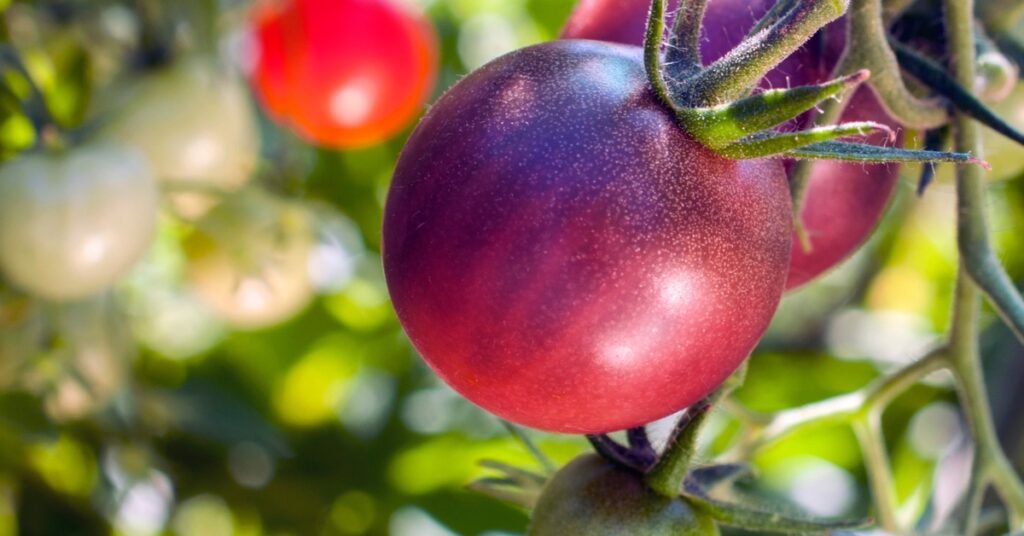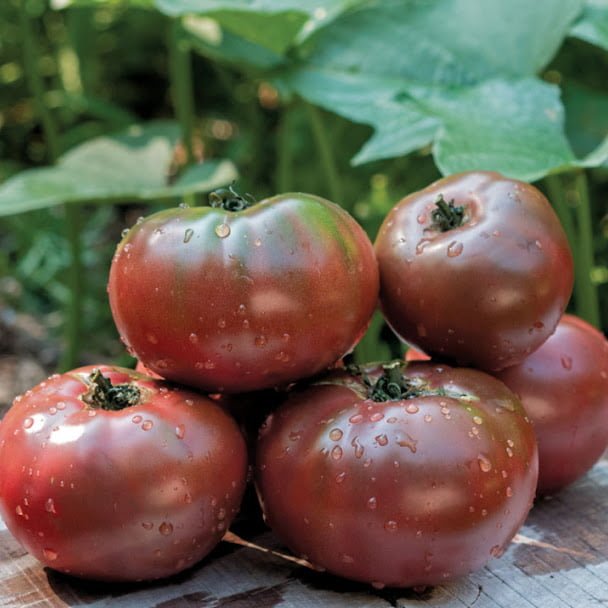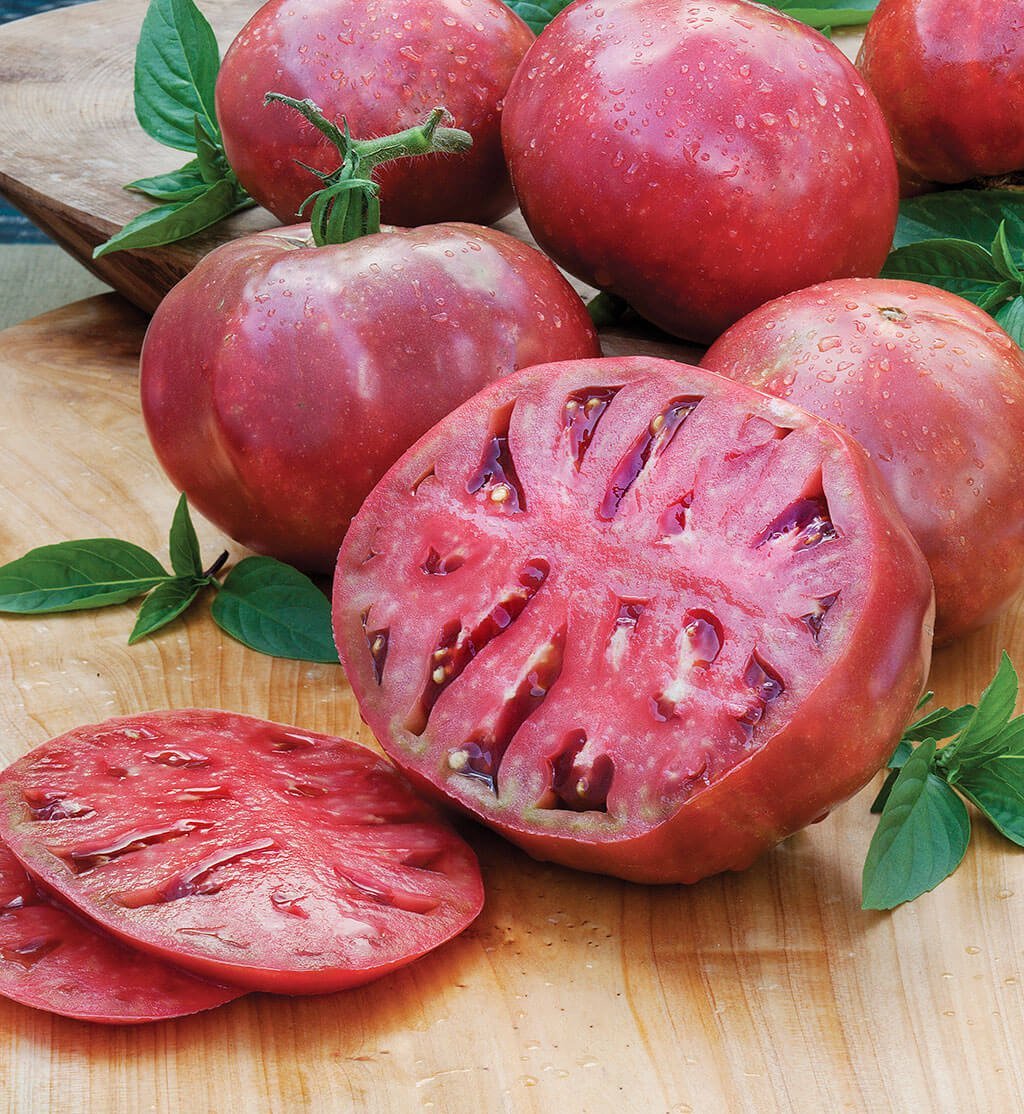The Cherokee Purple Tomato is an heirloom plant that originates from North America. It was passed down from the Native Americans of the Cherokee tribe. This heirloom tomato variety consistently ranks very high in taste tests. It is a beautiful dusky pink with a deep, rich–red interior. Cherokee Purple grows well in most regions of the U.S. The fruit should be allowed to ripen on the vine for the best flavor.
Cherokee Purple Tomato
| Common Names or AKA Names: |
|
| Botanical Name: | Solanum lycopersicum |
| Family: | Solanaceae |
| Plant Type (Zone 8b): | Indeterminate |
| Hardiness Zones: | Zones 5A through 10 (USDA) |
| Mature Size: | 6′ – 9’+ Foot Tall |
| Native Area: | North America, Central America |
| Bloom/Harvest Time: | 80 to 90 days |
| Sun/Light Exposure: | 8 to 12+ hours of Light. |
| Planting Depth: | 1/8 inch |
| Soil Preferences: | Well-Drained |
| Soil pH: | 6.5 to 7.5 |
| Aquaponically-Friendly: | YES | LEARN MORE |
| Hydroponically-Friendly: | YES | LEARN MORE |
DESCRIPTION:
A beloved heirloom as valuable for its flavor as it is for its unusual look, Cherokee Purple sets giant beefsteaks weighing about a pound and filled with intense violet-purple hues. This is a true legacy plant, believed to have originated more than 120 years ago in the Cherokee nation in Tennessee. The vining plant is very heavy bearing, and each of these tomatoes is a masterpiece of color, flavor, and history. Do not miss this valuable fruit from the American past.
Slightly ridged and very symmetrically shaped, these tomatoes combine juiciness with a strong tomato tang, the type unknown to those rock-hard supermarket varieties. They may need some support as they mature on the plant, their massive weight pulling them downwards. Stake this vigorous plant well and then offer a little extra help to bring in its crop of giants.
USE:
There are a thousand ways to eat Cherokee Purple tomatoes. They can be eaten raw, dried, canned, or sauteed. Most people pickle or render them to paste because they are best enjoyed through sight as well as taste. As an heirloom beefsteak, the Cherokee Purple tomato is best enjoyed fresh without cooking. It makes a divine sandwich, raising the already delectable BLT to astronomical heights. It also shines in a salad or simple, yet mouth–watering, spread of sliced tomatoes, basil, and fresh mozzarella. The sliced Cherokee Purple tomato is also delicious either plain or sprinkled with salt. If a hot dish is preferred, Cherokee Purple tomatoes can be diced and briefly sautéed with pasta. These heirlooms can also be grilled as a pizza topping or added raw to a halved and toasted baguette for bruschetta. Its flesh is a deep rose with wet and red, sometimes green, pockets of seed. The Cherokee Purple tomato’s flavor consists of a rich combination of mostly sweet, and some acidic, notes. Despite the relative sweetness of the tomato its flavor is in no way saccharine. Rather, it is balanced, complex, and slightly smoky.
Culture & Cultivation:
Purple Cherokee tomato plants grow well in places with plenty of sunlight. They are found in most places falling under the temperate and tropical zones. Grow your Purple Cherokee tomato plants in clayey or loamy soil in temperatures of 50 to 95 degrees Fahrenheit (10-35 degrees Celsius). Position it in a shaded corner where it is receiving indirect sunlight. Make sure to stake or cage them for support.
Heirloom tomatoes like the Cherokee Purple were not bred for specific disease resistance like many hybrid tomatoes. This makes them vulnerable to every tomato disease and insect infestation. The most damaging pests are aphids, blister beetles, tomato and tobacco hornworms and fall armyworms.
How to Grow Cherokee Purple Tomato From Seed
Cherokee Purple grows reliably from seed and, because it’s an heirloom, you can save seed from your own fruits to plant the following year.
- Plant seeds indoors or in a greenhouse 6 to 8 weeks prior to the last frost.
- Fill a cell tray or 4–inch pots with seed starting mix and plant the seeds about 1/8 inch deep.
- Water lightly or place the pots or cells in a solid bottom tray and add water.
- Once the seedlings have developed true leaves, they can be potted up into a soil based potting mix with fertilizer.
If you want to learn more about cultivating this specific plant, you might want to check out our online courses where we have plant specific mini courses in addition to our standard fully packed courses and master gardening courses.
Planting & Care:
Tomatoes require a long growing season, and are best started indoors 6 weeks before the anticipated transplanting date (after the final frost of the spring). Tomato plants prefer well-drained, fertile soil, high in organic matter. Fertile clays and loams produce the highest yields, but lighter soils that drain and warm quickly can produce earlier harvests. Tomato is a heavy feeder and should be fertilized with an organic blend rich in phosphorus and potassium, and containing moderate nitrogen.
Unlike most plants, tomatoes do better if planted deeper than they were grown in containers. Set them in the ground so that the soil level is just below the lowest leaves. Roots will form along the buried stem, establishing a stronger root system.
Common Problems
The Cherokee Purple tomato is a variety of tomato that is sensitive to variable growing conditions, which can result in several common problems. One such problem is blossom end rot, which manifests as a black sunken spot on the bottom of ripening fruits. This is caused by insufficient calcium uptake and is amplified by inconsistent watering and hot, dry weather. However, tomato vines grow quickly and an otherwise healthy plant can usually recover without intervention. It‘s not uncommon to see blossom end rot on the first early fruits disappear on newer developing fruit. Remove affected fruit so energy isn‘t spent on ripening a damaged tomato.
Blossom drop and poor fruit set is another issue that can affect Cherokee Purple tomatoes. This occurs when flowers form but fall off before developing fruit. The culprit is likely the weather, inconsistent watering, or a combination of both. Cherokee Purples are tolerant of short periods of drought, but they won‘t produce if allowed to dry out in hot, sunny weather. Fluctuating temperatures also result in poor fruit set, so it‘s best to wait until nighttime temperatures stay steadily above 55 degrees before planting your tomatoes in the garden.
Pale green or yellowing leaves on a Cherokee Purple tomato plant can be indicative of a lack of nutrients or poor nutrient uptake. Test your soil before planting to learn what might be missing. Additionally, bottom leaves will yellow and fall off during the growth cycle – this is normal. If yellow leaves appear in the tops of your plants however, revisit your watering schedule to see if too much or too little water could be the cause
Pruning
It‘s important to prune your Cherokee Purple tomato plants both early and late in the season. Early pruning is done by pinching out suckers—leafy new growth at the junction of two existing vines. This tomato can be trained into a slightly more compact form by removing suckers for the first several weeks after transplanting. The fruits will need shade from the leaf cover as they ripen, so you’ll want to avoid too much suckering since this can lead to scalding on the fruits.
Pruning late in the season is done with a heading back pruning cut on the vines. As cool weather sets in, this practice stops the plant from producing more flowers and fruit and directs energy to ripening fruits already on the vine.
You can remove non-productive vines and damaged stems and leaves throughout the season, provided you leave enough shade for the fruits. Use clean tools and make sharp, decisive cuts to avoid stripping and peeling the stems.
Growing new plants can be difficult at times but not to worry Green Grass Grove Academy is here to help! We are excited to offer Online Courses on plant care and other Gardening and Homesteading Courses. Our goal is to provide you with the knowledge and skills necessary to become a successful gardener. Our Online Courses are designed to be self-paced and to be completed at your convenience. Courses contain invaluable information to help you become the ultimate Gardener! In addition, Our Courses have entertaining multimedia, quizzes, and a final exam to test your knowledge. Upon completion of each course, you are eligible to receive a certificate of completion. Some of our most popular courses include Aquaponics/Hydroponics, Plant Pathology, Seeds & Seedlings, Microgreens, Plant Mini-Courses, and Insect Pest & Nutrients Management.
So what are you waiting for? Come on over to Green Grass Grove Academy and let us help you become the ULTIMATE GROWER!
Watering:
The Cherokee Purple tomato plant will do best with 1–2 inches of water per week. However, it can also tolerate short periods of drought. For optimal watering, install a drip hose system. Be sure to water at the soil line to avoid disease issues that can come from overhead watering. Tomato plants don‘t do well when sitting in water, so avoid over-watering as well.
Harvesting:
Your Cherokee Purples will usually take at least 80 days to reach harvest. However, like many heirloom varieties of tomatoes, they will often self–stagger the harvest over a week or two. Ripe tomatoes should be large with a strong, deep purple hue amongst their red background. The shoulders usually remain green but may get lighter in color when ripe.
- While the fruits are harmless, leaves and stems are toxic to cats, dogs, and horses.
- Cross-Pollination Alert!
Aphids | Whiteflies | Thrips | Caterpillars | Cutworms | Hornworms | Flea Beetles
Take Our Online Insect Pest Management Course to become an expert at dealing with these pests and others too!
Learn More About This Plant!
Lorem ipsum dolor sit amet, consectetur adipiscing elit. Ut elit tellus, luctus nec ullamcorper mattis, pulvinar dapibus leo. Lorem ipsum dolor sit amet, consectetur adipiscing elit. Ut elit tellus, luctus nec ullamcorper mattis, pulvinar dapibus leo.
- Beefsteak-shaped tomato that weighs above 16 oz on average.
- All tomatoes are vulnerable to a number of viral and bacterial infections. The best way to avoid problems is to grow a healthy plant in good soil. Tomato diseases overwinter in soil so crop rotation is highly recommended. Avoid planting tomatoes where other nightshade plants—peppers, eggplant, and potatoes—were grown the previous year.
- To reduce root disease risk, don’t plant on soils that have recently grown tomatoes, potatoes, peppers or eggplant for at least two years.
- Use black plastic mulch to warm soil and/or row covers, hot caps or other protection to keep plants warm early in the season. Remove covers whenever temperatures exceed 85 F.
- When tomato varieties are planted in close proximity, pollen from one variety can land on the female part of a blossom, the stigma, of a different variety and lead to some or all hybrid seeds being formed in that fruit. This is commonly referred to as a “cross–pollination“ or simply as a “cross.” When cross–pollination occurs, the fruit will look perfectly normal in the current season; however, the resulting seeds carry genes from each parent and will produce varying progeny in subsequent generations.
The information in this post is NOT medical/nutrition advice, as we are not doctors or nutritionists. This information is for informational/entertainment purposes only and is not a substitute for professional medical advice, nutrition advice, diagnosis or treatment. If you have any concerns or questions about your health or nutrition intake, you should always consult with a doctor or other licensed and qualified healthcare professional.
Green Grass Grove Plant Profiles
No posts found!






